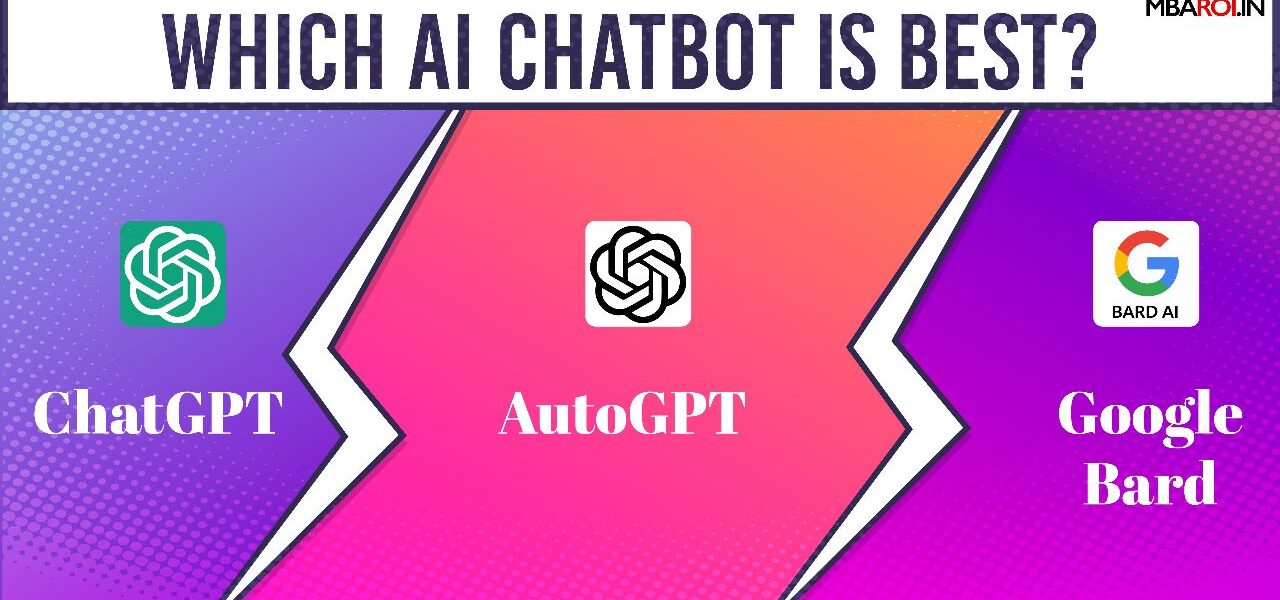Artificial intelligence has made remarkable advancements in recent years, particularly in the field of natural language processing (NLP). OpenAI, a leading AI-powered chatbot, has introduced several powerful language models that have revolutionized various applications. Among the most notable are ChatGPT, AutoGPT, and Bard. Each of these models possesses unique features and capabilities, making it essential to understand the differences to choose the most suitable one for specific tasks.
ChatGPT: Empowering Conversations with AI Language Processing:
ChatGPT, developed by OpenAI, is an AI chatbot powered by NLP technology. It undergoes continuous fine-tuning based on user feedback to enhance its human interaction capabilities. With its vast knowledge, ChatGPT excels at tasks like essay writing, email composition, storytelling, and code generation. By gathering information from the web, ChatGPT delivers concise and conversational responses to user queries.
Launched in November 2022, ChatGPT utilizes web data and predictive computing to engage in discussions and provide accurate answers. Through its generative AI platform, the chatbot constantly learns and expands its knowledge across various subjects.
In March 2023, OpenAI announced an upgrade for ChatGPT, integrating the GPT-4 large language model. This enhancement enables future interactions with ChatGPT using text and images, giving it a competitive advantage. Notably, GPT-4 is also utilized by the AI-enabled Bing Chat.
AutoGPT: Leveraging AI for Autonomous Task Execution and Language Processing
Auto-GPT, an “AI agent,” employs OpenAI’s GPT-4 or GPT-3.5 APIs to autonomously accomplish goals by breaking them into sub-tasks and utilizing the internet and other tools. It adapts and generates responses to prompts, manages memory and context, performs internet-based actions, and even features text-to-speech capabilities. While Auto-GPT showcases impressive abilities such as code writing and debugging, it cannot modify its underlying models or access its own system code.
OpenAI’s release of GPT-4 on March 14, 2023, marked a significant advancement in language models, although it lacks autonomous action capabilities. Auto-GPT, developed by Toran Bruce Richards, gained widespread attention upon its launch on March 30, 2023, becoming popular on platforms like GitHub and Twitter.
Google Bard: An AI Chatbot for Conversational Engagement and Marketing
Bard, an AI chatbot developed by Google, emerged as a direct competitor to OpenAI’s ChatGPT. Initially relying on the LaMDA and later the PaLM family of large language models (LLMs), Bard garnered mixed reactions when it was released in a limited capacity in March 2023. However, it gradually gained momentum and expanded its availability to additional countries.
Despite its lukewarm reception at first, Bard made a significant entrance into the social media marketing industry. Google’s dedication to refining Bard’s capabilities and performance became evident as its reach expanded across various countries. This expansion showcased the value Bard brings to businesses, positioning it as a valuable tool in the realm of social media marketing.
Let’s take a deeper look at the technical differences between these AI engines.
ChatGPT vs AutoGPT vs Google Bard
| ChatGPT | AutoGPT | Bard | |
| Conversation | Excels in dynamic and interactive conversations. | Limited conversational abilities. | Limited conversational abilities. |
| Text Completion | Moderate proficiency in text completion tasks. | Strong proficiency in text completion tasks. | Limited proficiency in text completion tasks. |
| Text Generation | Competent in generating coherent and relevant responses. | Strong ability to generate high-quality text continuations. | Specialized in crafting poetic expressions and language artistry. |
| Use Cases | Customer support, general-purpose chat applications. | Content generation, text summarization. | Poetry creation, language artistry. |
| Strengths | Engaging conversations, context understanding. | Text completion, generating coherent text. | Poetic expression, understanding language aesthetics. |
| Limitations | May provide inaccurate or nonsensical responses. | Limited contextual understanding. | Limited contextual understanding. |
| Suitable For | Chatbots, virtual assistants, interactive applications. | Automated writing tasks, content generation. | Projects requiring poetic flair and artistic expression. |
Comparative Analysis: ChatGPT vs AutoGPT vs Google Bard:
While ChatGPT, AutoGPT, and Bard share the same underlying GPT architecture, their training and fine-tuning processes differ, resulting in models with distinct capabilities.
- Contextual Understanding: ChatGPT’s strength lies in its deep contextual understanding, enabling it to engage in interactive conversations and respond naturally to user queries.
- Code Generation: AutoGPT shines in code-related tasks, providing suggestions, completing code snippets, and assisting developers in debugging and automating coding tasks.
- Creative Writing: Bard’s specialty lies in generating imaginative and coherent narratives, poems, and literary pieces, making it an ideal companion for writers seeking inspiration and assistance in their creative endeavors.
Factors to Consider:
- Task Requirements: Evaluate your project’s needs and determine whether you require conversational capabilities, code generation, or creative writing assistance.
- Domain Expertise: Consider the domain in which the model will be applied. If it is related to customer support or virtual assistance, ChatGPT might be the best fit. For programming-related tasks, AutoGPT is the go-to option. If creative writing is your focus, Bard is the model to explore.
- Training Data: Understand the training data used for each model and assess its relevance to your project. Consider the quality and diversity of the training data to ensure optimal performance.
Choosing the Right Model:
To select the most suitable model among ChatGPT, AutoGPT, and Bard, consider the specific requirements and objectives of your task. If you need a conversational agent or a chatbot, ChatGPT is the optimal choice due to its ability to engage in dynamic conversations and provide accurate responses.
For text completion, generation, or content creation tasks, AutoGPT should be your model of choice. Moreover, its expertise in extending and completing text prompts makes it an invaluable tool for automating various writing-related tasks.
If you are specifically looking to infuse artistic creativity or poetic elements into your project, Bard is the ideal model. Its proficiency in crafting poetic expressions and understanding language aesthetics will help you create captivating and artistic content.
It is worth noting that OpenAI continues to improve and refine these models, often releasing updated versions with enhanced capabilities. Staying informed about the latest updates and advancements from OpenAI will enable you to leverage the most cutting-edge AI models.
Wrapping Up:
In conclusion, selecting the appropriate AI language model depends on the specific needs and objectives of your project. ChatGPT excels in interactive conversations, making it ideal for chatbots and customer support applications. AutoGPT is excellent for text completion and generation tasks, automating content creation and extending text prompts. Bard specializes in poetic expression and language artistry, bringing a creative touch to projects requiring artistic flair.
By understanding the strengths and capabilities of ChatGPT, AutoGPT, and Bard, you can make an informed decision and leverage the right model to enhance your applications, streamline your processes, and create captivating and engaging content.
As AI technology advances, it is essential to stay updated on the latest developments from OpenAI and explore new models that may better align with your requirements. Ultimately, choosing the right model will enable you to unlock the full potential of AI and achieve your desired outcomes.
You May Also Like:




